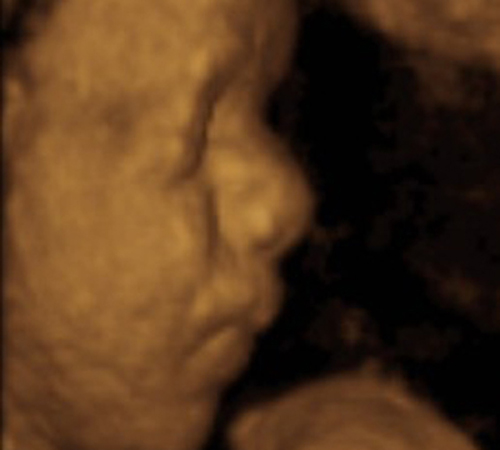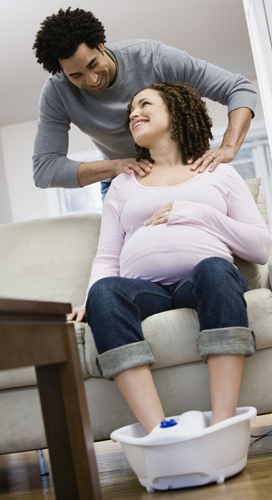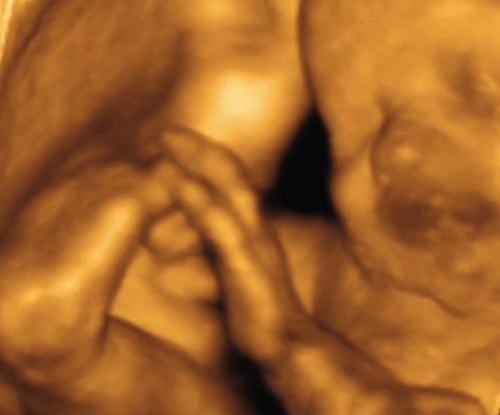You are 29 Weeks and 2 Days 75 days to go…
Your baby’s nerve cells are developing, but they are still not mature enough for her to feel pain, temperature, or touch.
Your baby today
Now the bridge of the nose is more apparent than earlier in the
pregnancy. The tip of the nose can still look slightly upturned at this
stage adding to the “button nose” appearance. As the face lengthens, the
tip of the nose does move downward slightly.

Electrical activity
can now be detected in the increasingly convoluted folds of gray
matter, the part of your baby’s brain that controls the higher
functions, such as memory and consciousness, as well as muscle control
and sensory perceptions, such as seeing and hearing.
The neurons of the
cortex—the outer layer of gray matter—have started to develop into six
distinct layers with separate functions, a process that will be
completed in about five weeks, although further maturing will be needed.
Your baby is born with almost a full complement of neurons, but there
is further growth in early childhood.
For nerves to
function effectively and signals to pass along them faster, they need
insulating. In a process known as myelination, the nerves are insulated
with myelin sheaths of fat. Although all of the components of the
nervous system are present from an early stage of development, the
peripheral sensory and motor nerves, spinal cord, and brain need the
entire pregnancy to develop and function as a unit.
The nerves of the
brain and spinal cord carry the sensations of pain, temperature, and
touch. However, the process of myelination is ongoing and will not be
complete until the final few weeks of pregnancy, so your baby does not
register or recognize pain, temperature, and touch at this stage.
A massage is soothing and relaxing and can be very welcome attention as you wind down toward the birth of your baby.

… Doctor
| Q: |
The reality of having to give birth is hitting me now! How can I avoid getting too anxious?
|
| A: |
A little way into your third trimester, the reality of
childbirth may sink in. You may be experiencing some pregnancy
discomforts, including Braxton Hicks’ contractions, which give an indication of what is to come.
First of all,
remember that the calmer and more relaxed you are, the easier your birth
will be. Try to use a little positive visualization—your baby coming
out easily in a “whoosh” of fluid, and focus on contractions being
“positive pain” to bring your baby into the world. Remember that your
baby will be fine, however long she takes to arrive, and that your pain
and discomfort are all controllable. In other words, even if you decide
on a natural birth now, you can get help and relief when you need it.
Try to relax and
enjoy the last months of your pregnancy. Treat yourself to a massage,
and keep yourself busy—perhaps undertaking a creative project for your
new baby. Above all, don’t worry. Think about childbirth as welcoming
your baby into the world, and focus on this rather than any concerns.
|
You are 29 Weeks and 3 Days 74 days to go…
Start getting your baby’s room ready now, while you still have the energy for shopping and helping with decorating.
Your baby today
Your baby often grasps one hand with the other or, as this image
shows, grasps a foot. This helps with important sensory feedback to the
brain as the nerves within the brain start to mature and become
insulated along their length to carry signals more effectively.

It’s recommended that your baby sleeps in the same room
as you for the first six months, but many parents-to-be still like to
prepare the baby’s bedroom. This room can still be used for the baby’s
clothes and any newborn gifts you’re given. You might also want to
breast-feed, and set up a diaper-changing area in there.
Check out garage sales
and eBay for second-hand baby equipment. This can be a good opportunity
to buy some bigger items at a reduced price. If you do buy a second-hand
crib, make sure it’s certified by the Juvenile Product Manufacturers
Association and that the slats are no more than 23/8 in apart. Hand-me
down clothes, sheets, and towels also save money. If this isn’t your
first baby you may find that you have more or less everything you need,
except for disposables, such as diapers (unless you are using cloth
diapers—see Choosing diapers).
Although it’s good to
be prepared (and sometimes babies do arrive early), remember you won’t
be trapped in your house forever so you don’t need to prepare as if for a
siege. If you don’t have something you need or you run out, you can
always get it after your baby is born.
If you don’t know the sex of your baby, opt for a neutral color scheme for your baby’s room. If you do know, then you can decorate accordingly.

… Doctor
| Q: |
Do I need a carriage/travel system/stroller?
|
| A: |
Most parents-to-be are unsure about the type of stroller
they’ll need for their baby and, since there are a number of options and
types available, this can make choosing the right item difficult. You
will need to buy some type of travel equipment for your baby and what
you choose will vary depending on your circumstances.
If you mostly drive a
car, you may want to consider a car seat that attaches to a carriage,
or a car seat and separate travel crib. If you intend to walk a lot, you
may find a lightweight stroller more appropriate than a carriage. Keep
in mind how long your baby will be in the stroller: it must be
comfortable, have a lie-flat option for the first six months, and
adjustable seat options as your baby grows. The stroller must also be
weatherproof.
If you do a lot of
“around town” travel, you might consider a lightweight option in
addition to your main system. It’s a good idea to take a look around in
stores and online to compare different models and get the best price.
|
Planning for your Birth
As your due date
approaches, you may start to think in greater detail about how you would
like to manage your labor and birth. Being informed will help you feel
more confident about the choices you make.
Your choices for birth
When planning the type
of birth experience you would like to have, you’ll need to consider a
number of factors. One of the most important decisions is where you
would like to give birth. You may also want to think about the details
of your birth, such as which positions you would like to adopt during
the birth, and what type of pain relief you might choose to use .
It’s important to be
flexible. You may have preferences as to the type of birth you want,
but accepting that your choice may be limited or advised against because
of a preexisting medical problem, or because a problem arises in labor,
will help you prepare mentally and curb disappointment if events don’t
go as planned. It is generally accepted that the care of healthy women
in labor who have had a straightforward pregnancy should be monitored
and managed by their doctors at the hospital, with support given by the
nursing staff throughout the process.
The place of birth
Earlier in
pregnancy, you’ll probably have thought about where you would like to
give birth and discussed the options with your doctor. Although you may
have already stated a preference, it’s important to know that you can
review your choice and change your mind toward the end of pregnancy.
Where you give birth
may be influenced by factors such as whether you’ve had complications in
pregnancy, such as gestational diabetes
or high blood pressure, that would make a hospital birth preferable. On
the other hand, if your pregnancy has been straightforward and you have
become more informed about labor and birth over the course of your
pregnancy, your confidence may have grown and you may decide to look
into a home birth in familiar surroundings, or to investigate
midwife-run birthing centers in your area.
Sometime in the
third trimester you may have a hospital tour, which gives you a chance
to see the labor and postpartum wards in your hospital, and to ask
questions about hospital policies and what facilities are available. Ask
your doctor for details of tours.
An active labor
In prenatal classes,
you’ll learn a range of techniques to help you cope with pain during
labor. Most methods center around breathing and relaxation techniques
that help you focus during labor and birth and don’t inhibit movement.
Maintaining mobility and an upright position during labor is thought to
help you deal with contractions and to use gravity to help push your
baby down the birth canal.
If you want an active birth, this may influence how you feel about the type of pain relief you want to use (see Your pain relief options) and about monitoring in labor. For example, continuous monitoring
can limit your movement. If the doctor wants to monitor your labor
continuously, talk to her about how you can maintain some mobility; for
example, by sitting on a birthing ball, or adopting an all-fours
position on the bed or on a mattress on the floor.
Your pain relief options
Factors that may influence the type of pain relief you would like include how active you want to be (see An active labor); what effect different drugs may have on how you experience labor; and how drugs can affect the baby.
Natural methods, such as breathing techniques, laboring in water, and TENS , and some medical pain-relief options, such as analgesics
allow an active birth because you won’t lose all feeling or muscle
movement. However systemic (IV) analgesics cross the placenta and can
affect the baby’s breathing at birth. Regional anesthetics, such as
epidurals , limit movement and can mean that you won’t feel when you’re pushing.
Focusing on your birth preferences helps you to consider your options and feel mentally prepared for labor.

Making a birth plan
Writing your
preferences in a birth plan helps you to consolidate your thoughts and
to pass this information on to your doctor. Or your doctor may discuss a
birth plan with you. A birth plan is useful too for your birthing
partner, who may need to advocate on your behalf in labor. Birth plans
also allow you to state any special needs you may have, such as whether
you have a disability.
Make your
birth plan straightforward and accessible. Working with your caregivers
as a team will help you deal well with labor and be involved in decision
making, whatever the outcome.
New procedures
Stem cell collection
The collection of stem cells, which are found in the umbilical cord,
is a relatively new private service. Stem cells develop into many
different types of cell in the body and can be used to treat diseases
such as leukemia by replacing diseased cells (see Stem cell collection).
Stem cells are collected from the umbilical cord immediately after
birth and sent to a laboratory where they are frozen and stored, acting
as health insurance for the baby in future life. If you want to have
this done, you must make arrangements with a private company and check
that the hospital has procedures to allow the collection to be done.
Thinking about the birth
Questions to consider
When planning where and
how you ideally want to give birth, you need to consider both what you
would prefer and what the hospital or birthing centers can offer. The
following questions may act as helpful prompts.
Questions to ask yourself
Who would you like to have with you during the labor and birth?
Do you want an active labor?
What pain relief do you want?
If you have an assisted birth, would you prefer vacuum or forceps?
Do you want your partner to be present if you have a cesarean?
Do you want the third stage of labor to be managed naturally or assisted with drugs?
How do you want to feed your baby?
Questions to ask the hospital
What is the policy on induction? Will the hospital monitor your baby before labor if you don’t want to be induced?
Will the choice of pain relief and the place of birth change if you’re induced?
Are there tubs or birthing pool facilities?
Will you be able to bring in aids such as massage oils or music?
How much privacy will you have?
How many people will you be allowed to invite into your labor and delivery room?
Will your baby remain with you throughout your stay in the hospital?
Does the hospital have facilities for sick babies, or are babies transferred?
Can you go home when you feel ready, or is there a set discharge time?
Birth ideologies
In the mid-20th
century, labor and childbirth in the West became highly medicalized. In
reaction, several childbirth philosophies emerged that focused on
empowering women and viewed childbirth as a natural rather than a
medical experience. Many of these approaches are now integral to the way
childbirth is managed today.
Dr. Grantley Dick-Read,
an American obstetrician, linked labor pain to fear when he was working
during the 1950s. He promoted breathing and relaxation to help cope
with pain, and his methods are now commonplace.
Dr. Ferdinand Lamaze
was inspired by the Russian scientist Dr. Pavlov, who trained dogs to
have a set response to stimulus. In the 1950s, Lamaze extended this idea
to childbirth, believing that women could be trained to respond
positively to labor pain.
Sheila Kitzinger, a well-known birth practitioner who became prominent in the 1960s, believes in a woman’s right to choose how to give birth.
Frederick Leboyer, a French obstetrician, came to prominence in the 1970s with his book Birth without Violence.
Focusing on the baby, he believed a traumatic birth could impact
negatively later in life. He promoted “gentle birthing” where the baby
has skin-to-skin contact and is immersed in warm water.
Michael Odent,
a birth practitioner, advocates active birthing, believing women act on
instincts in labor. His birthing center in Pithiviers, France has the
lowest national rates of intervention.
Janet Balaskas founded the Active Birth Movement in 1981. At her Active Birth Centre in London, she teaches relaxation, breathing, and yoga.